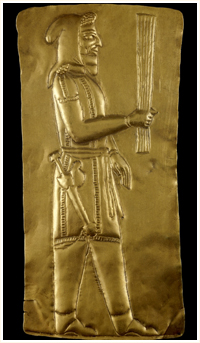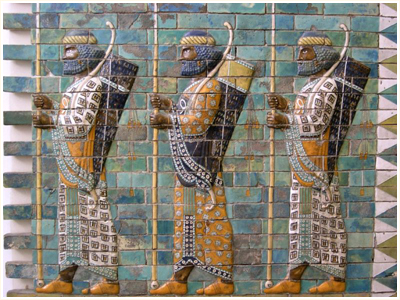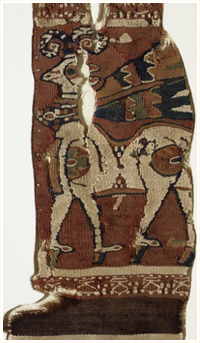
Median Magi (priest) Oxus treasure,
5th – 4th century BC; British Museum
|
Iranians used the cosmetics, ointments and fragrances popular in the area and, by controlling the trade routs, made a bundle importing and exporting such goods all over their territories. However, the cosmetics were in use long before the Medes and the Persians arrived. White powder made of lead or silver and red from hematite stone are discovered in Kirman, along with tweezers during excavations at Shahdad and Khabis sites from 5,000 BC. Eye and face paints oils and solid fats were used. The most common eye paint in the area, kohl, was used as a compact mass of finely ground material made either into a paste or into a powder. Egyptians used Malachite and galena extensively for making the eye paint kohl (sormeh). However, due to the abundance of antimony in Iran, this substance was more likely used to make the eye paint.
Lip paints were popular and very likely red ochre, since pre-historic times, was utilized for this purpose. Facial powders were made from red oxide of iron (hematite), yellow ochre and white powder (silver or lead), all abundant in Iran. Such material was mixed with fats, oils or gum resin to make application easier. Henna was used extensively and was obtained locally from the leaves of Lawsonia alba. Animal and vegetable oils and lime or chalk were utilized to make facial creams, some used for cleansing. Oils and fats, and plant products such as resins and gum resins were scented and used as perfumes. Local myrrh an oleo-gun resin and cinnamon, traded extensively in the area, was used to produce perfumes and mask bad odors.
Clothes were simple wool and latter on cotton and silk were used as materials and were commonly produced by individual household for everyday use and by large workshops for commercial purposes. Fabrics were dyed and designs were hand-painted for the nobility. |
The needles of the day were coarse and bulky which meant stitching or sewing produced less than elegant garments unless the tailors spent enormous amount of time on the items. Clothing was held together with safety pins and buttons and buckles were used extensively. Footwear showed little distinction between ordinary males and females. One usually wore sandals tied round the ankle with thin strips of leather. There were outdoor footwear made from soft leather and slippers were used as well. Animal fur and leather were used extensively.

Persian guards from Susa (Shush) 5th century BC
The Greek conquest of Iran and the subsequent Seleucid dynasty popularized Greek styles and culture in Iran. At the same time, Iranians influenced Greek traditions. The Parthian dynasty popularized Iranian fashion styles all over the continent. Queen Zenoba, the ruler of Palmyra (Syria), made a pact with the Parthians and fought against the mighty Rome and lost. She was very found of Iranian styles and is portrayed dressed in Parthian attire, despite the fact that Rome was the center of fashion and style at the time. The ancient cultures were very diverse and willing to adopt ideas and trends without prejudice. At the Parthian city and fortress Nysa (near Ashkabad in Turmenistan) Iranian, oriental and Hellenistic objects, ornaments and jewelry are discovered side-by-side. Headgear was as popular as before and gold with precious and semi-precious stones were used extensively for jewelry etc.

Parthian nobility, Hatra (modern Iraq) 2nd century AD
The Sassanian period was the peak of Iranian culture and art. Hundreds of items at major museums in Europe, the USA (Metropolitan in New York and Arthur Sackler in Washington DC are good examples) and the Hermitage Museum in St. Petersburg in Russia are a testimony to their talent and creativity. The upper classes amassed enormous wealth and lived in splendor. Remnants of carpets from the period show incredible designs with animals, trees and even gardens similar to the classical designs still used. Fabrics for clothing were woven with the same elegance and creativity. The Sassanian fabrics, such as silks and designs, became famous all over and were copied and exported to China, Japan, Byzantium and Europe. Some examples have survived in the Vatican and other major churches in Europe.

Sasanian textile, 7th century,
Metropolitan Museum, New York
|
There is little information on what the rich Sassanian women would use for cosmetics. However, the Roman sources contain a wealth of information and the women of Persia would have used almost the same ingredients and mixes. All ancient formulas were still in use with new ones added. Face powders were made from powdered chalk (sepeedab) or white lead. Eye shadows were used, and the eyebrows were thickened or the length was added on as it is done today. Eyeliner (sormeh) was made from soot or antimony powder. Saffron was also used in both eye shadow and perfume. Some women used black patches or beauty spots on their faces, particularly if they wanted to hide some sort of blemish. Red for colouring the lips was obtained from ocher or ficus (a lichen-like plant). Ocher was also used to add colour to the cheeks (sorkhab). Make-up for the face was mixed in small plates. Face creams were sometimes made of milk and flour; and lanolin (from unwashed sheep's wool) was used as a skin lotion. Face powders, make-up, and perfumes tended to be applied liberally. Rose water was used extensively and remained an important item all the way up until the early 20th century. Beards and long hair remained fashionable for men; women are normally portrayed with long hair; royalty is always portrayed with their own crowns. |
|

